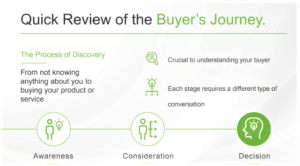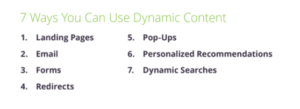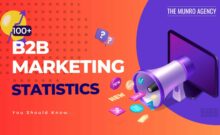Personalised Content
Consumer and business buying habits have changed, and so has your customer’s buyer journey. As marketing has evolved over the years, and the advent of the internet age brought about significant change, it has influenced and significantly transformed the sales and marketing process.
The buyer’s journey has shifted from a seller-controlled experience, where everything happened in the form of face-to-face communication, to a self-powered and self-guided tour by a buyer on the internet. Previously, the focus of the buyer’s journey was on the seller’s contact with a potential buyer, but now it is more focused on the buyer finding what they need on their own. This is the concept of using Personalised Content.
Table of Contents
What is the buyer’s journey?
The buyer’s journey is the movement of a buyer from the initial stage of awareness through to consideration, where they are eliminating competitors, to when they then decide to purchase an item. The critical thing about this journey is that communication needs to happen at each stage. Also, this communication changes at each step of the buyer’s journey.
Let’s look at the experience of buying a car.
In the ’90s, when someone needed to buy a car, they would probably look at television for ads or read the newspaper for car dealers. After this, they would probably go to the dealership and talk to a salesperson before buying the car. Fast forward to the current times, the experience of buying a car is wildly different.
People go online first and search for auto manufacturers and then look at car review sites before they even talk to a salesperson. When they go to a dealership, they know exactly what car they want and how much they should pay for it. Crazy difference, right?
The Difference Today
If you compare and contrast these experiences, you’ll realise that a real shift has happened. Today, the buyer’s journey has really shifted from a seller-controlled experience, where everything happened in face-to-face communication, to a buyer-powered experience that allows customers to get the information they want on their own terms.
The critical thing to understand about the buyer’s journey is that critical communication needs to happen along the entire journey and that communication needs to occur at each stage of the buyer’s journey. In the past, the buyer’s journey involved unique experiences, unique decisions, and unique points of interest for each person.
This has, however, changed where buyers are treated as a whole and not as individuals. Now, buyers wander in the dark, searching, sorting, and sifting for static data points from a sea of information. Sellers also overwhelmed buyers with generic content and glorified digital billboards. But, what if you could bring back the previous era of human conversations and mix it up with the new era of digital marketing?
A New Approach
You need to take a hyper-personalised approach that is more meaningful, engaging, and fulfilling for both the buyer and you, the seller.
Marketing automation makes it possible to create hyper-personalised content and put it in front of the right people at exactly the right time in the buyer’s journey. It refers to a set of tools that you can use across the marketing funnel that seeks to offer real-time responsive communication to potential buyers through technology.
It enables you to leverage features such as web visitor ID, dynamic list building, next-generation emails, campaign tracking, dynamic landing pages, CRM integration, and lead scoring to engage a buyer as a unique individual. You get to do this through ongoing, two-way, hyper-personalised conversations.
Increased Conversion with Marketing Automation
Munro Agency makes use of marketing automation to enable personalised conversations based on the content that marketers create. The focus is on putting the right message in front of the right people at the right time in their buyer’s journey. Personalised content can double the conversion rates on your website. Personalised email communication has a significant increase in both open rates and click-through rates. This results in increased conversion rates across the board.
Companies that adopt personas to categorise their leads and prospects will have significantly better results. The idea behind this is to widen the sales funnel from top to bottom across the whole funnel. This happens because marketing automation helps you drive leads to the top of the funnel when they become aware of your product or what you have to offer.
Personalisation and personalised content make them move further down the funnel and help you turn the leads into opportunities. Once you have the opportunities, you can use our tools to turn them into sales and conversions.
Personalised Content Best Practices
You can also improve your conversions by taking up new practices that provide you with better results. The first thing you need to do is to eliminate the following practices that could be the reason why your marketing efforts are not working:
- Static, one-way websites
- Digital billboards
- Generic email blasts
- Treating all leads equally
- Having the same conversation with all leads
Instead, take up these best practices for higher conversions:
- Adaptive websites based on needs
- Hyper-personalised relevant emails
- Qualifying leads based on behaviour
- Smart, responsive websites that engage users
- Two-way communication with buyers
- Custom nurturing based on funnel stage
How exactly does Marketing Automation Enable Hyper-personalisation? At every stage of the traditional marketing funnel, as leads moved through the funnel, more than 50% of them disappeared, leaving you with few conversions at the end.
Traditional Marketing Funnel
In a traditional marketing funnel, most of the leads go flying right past your funnel. The ones that get into your funnel exit the funnel constantly as they work through the buyer’s journey. In the traditional funnel, there is minimal communication, nurturing, and personalisation which is why very few leads convert. At every step of this marketing funnel, more than 50% of leads get lost at each stage of the funnel.
Marketing automation allows you to tailor the first 85% of the buyer’s journey with hyper-personalised conversations in real-time. It helps buyers to get the answers to the specific questions that they are asking instead of having generic content that is broad and not specific. It provides real-time responsive communication.
Marketing automation is also helpful to a seller because it helps them qualify leads. This means that they can identify which leads they should work with and where they should spend their resources. Through marketing automation, you can integrate modern digital marketing methods into the traditional marketing funnel.
Driving Leads
When it comes to driving traffic and lead generation, one of the tools you can use is next-generation email campaigns. These are dynamic emails that adapt to make the content more personal to the receiver. Another tool you can use is AdWords integration, which allows you to see the keywords that people are searching for, which led them to your website. You can create a strategy that allows your website to adapt in real-time to that information. Other marketing automation tools that you can use to drive leads include campaign tracking, dynamic landing forms and landing pages, visitor ID, and analytics or reporting.
Dynamic forms can change based on the information you already know about a lead, where they only include questions for information that you do not have. Dynamic emails also vary depending on the information that you have about the recipient, such as user experience and behaviour on your website. Giving people information about what they want at that moment leads to conversions more often than giving them generic information.
Nurturing
This is where you can collect every meaningful information about the lead on a single timeline and use it in a variety of ways to personalise your communication with them in an automated fashion. You can wrap use all your interaction and tracking in a lead score, which is a numerical representation of how interested your lead is in your product or service and how much of a fit they are to your product or service. This eliminates leads who are interested but are not a fit because they are not likely to convert.
Another tool that you can use can here is dynamic list building, with which you can create dynamic lists based on user behaviour. As new members meet the set criteria, they are automatically added to the list and, and as other members break the rules the system removes them from the list. The third tool that is useful for nurturing is the use of persona’s where we can group people based on their behaviours and interests. This enables you to write content specifically targeted to a specific persona. Other tools you can use at this stage include behavioural-based lead tracking and dynamic behaviour-based email drip campaigns.
Closing
This is where all the tools you have been using tie in to make a sale. Some of the marketing automation tools that you can use to close the deal include CRM/CRM integration, lead scoring, social integration, sales management/ notification, smart emails and trackable media, sales email automation for post-contact nurturing, end to end ROI, reporting, and analytics, sales automation dashboards, and shopping cart integration or abandonment. Using these tools will produce more leads at the top of the funnel, and the process repeats itself. Combining marketing automation and hyper-personalisation, therefore, leads to a broader funnel.
Personalise your marketing with dynamic content
The goal of delivering personalised content isn’t just to increase conversions, but also to meet the growing expectations of your customers. In the past, website users were amazed that they would get recommendations for products that piqued their interest. Today, users expect that they will get these recommendations from various platforms such as Netflix and Amazon. More than 74% of users get frustrated when they do not get personalised content from a website.
So, how can you meet this high demand in the market? The answer lies in using dynamic content. It is the best way to offer personalized content to your audience.
Dynamic content has more or less made static content marketing obsolete. Delivering dynamic content to your audience is all about making your content tailored to each website visitor, and not just auto-generated. It means having elements on your website or email that change depending on a user’s past behaviour or information.
An example of dynamic content is where an image for a marketing email will change to a beautiful travel destination because you searched for top travel destinations last week. To understand the concept of dynamic content better, let’s look at some real-world examples.
Amazon
Amazon was actually the pioneer of dynamic content in the retail space. When you go to the Amazon website, you will find that the product ads suggested for you will either be in line with what you have searched for on the Internet before or something that is in line with your interests. No, that’s not magic. It’s dynamic content.
Netflix
Netflix also uses dynamic content to improve your experience on the platform. They track what you’ve been watching and give you recommendations based on your tastes and preferences. Their entire homepage is filled with aspects of dynamic content, and you’ll find that your Netflix homepage will be completely different from the next person’s homepage.
As the most visited website in the world, Google has not been left behind. One way Google uses dynamic content is to personalise its content based on your location. When you search for “a shop or service near me”, you will get suggestions based on your location. A person in Chicago, US, and another person in Glasgow, UK, will see completely different results.
How can dynamic content work for you?
Understanding how dynamic content works is the first step. The next step is to understand how dynamic content can work for you. Marketing automation platforms make it much easier for you to provide dynamic content to your audience.
Once your website is up and running, begin collecting relevant data and information about your customers. This includes things like location, name, their purchases, and which pages they visit. You can then use this data to create targeted emails and landing pages. Some elements you need to provide users with dynamic content include:
A marketing database
When you start collecting data about your website visitors, you need to store it in a central location. Each user will have a unique ID, and even interactions they have on the website, which the system will record and store within the database.
A dynamic content generator
The function of a dynamic content generator will be to take data from your database and display it on the email or the page. The generator will use various elements and automatically display them based on the available data.
A landing page that can be edited
You must build your web page in a malleable way so that the content generator can work. Having an editable landing page will let you place the dynamic content code as needed and implement other aspects of personalisation.
How can you use dynamic content for personalised content?
There are so many ways you can integrate dynamic content into your marketing strategy. Here are some of the most common examples that you can start with:
Landing Pages
Having a landing page is a great way to convert users to customers. You can use dynamic content on a landing page by integrating the leads’ name of the lead into the page design or referencing their recent searches of interests. You can also personalise the call to action for better results.
Emails are some of the best channels to integrate dynamic content. You can go much further than just having the user’s name on the email. You can change email content depending on the browsing history or location of the user.
Forms
Personalised forms have higher chances of getting sign-ups. Your website can offer different versions of a form to users depending on their individual information. You can even have different offers depending on their stage in the buyer’s journey.
Redirects
You can also use redirects to convert users into customers. Depending on their most frequently visited pages on your website, you can redirect them to a page with more information about what they are looking for.
Pop-ups
You can use dynamic content to personalise your Web page pop-ups by using the length of user inactivity, time spent on the page, and user clicks. You can even use pop-ups to redirect users to different pages.
Personalised recommendations
With personalised recommendations, you can also personalise content to your visitors. Amazon and Netflix do this, and so can you, too. Recommendations don’t have to be product-based; you can base them on the users’ behaviour on your website and what their interests are.
Dynamic searches
You can use site-wide data and individual user data to deliver a user-friendly, personalised experience to your website visitors when they are searching for something on your page. One way you can do this is by providing results based on user experiences or by suggesting the most frequent search queries.
No doubt, personalised content is a game-changer. No need to worry if you’re not sure how to start. We have taken care of the hard part for your business. At Munro Agency, we offer a variety of marketing automation tools that help you generate personalised content that converts; and we’re happy to offer you a free trial. Simply give us a call today at +441412126354 or send an email to [email protected]. We are a SharpSpring Platinum Agency dedicated to helping you bridge the gap between your sales and marketing efforts. Reach out to us today and request a free trial.



















Leave a Comment